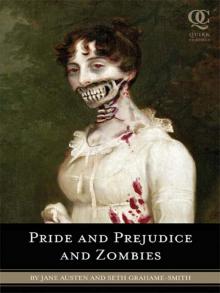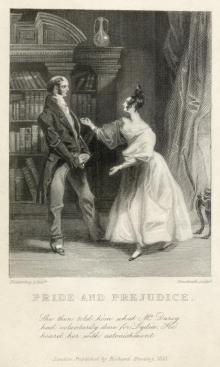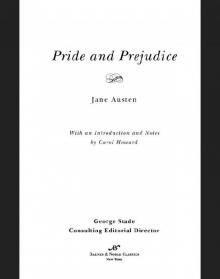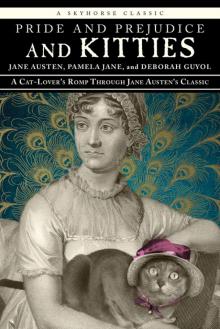- Home
- Jane Austen
The Annotated Emma Page 2
The Annotated Emma Read online
Page 2
Unfortunately, she was not able to savor this success long, for during 1816 she grew increasingly ill. Her ailment has never been identified for certain, though many have suggested it was what is now known as Addison’s disease, an endocrine disorder caused by a malfunction of the adrenal glands. She did manage to finish Persuasion and to begin another novel, Sanditon, before growing too weak to write. On July 18, 1817, in the town of Winchester in Hampshire, where she had gone to seek medical help, she died. Persuasion and Northanger Abbey (the new title of her earlier novel Susan) were published later in the year, along with a brief biographical notice by her brother Henry that finally revealed her identity to the world.
Emma stands out as the one Austen novel named for its main character. This is not accidental, for the novel centers around this character to a greater degree than in any other (the one exception is Northanger Abbey, which was originally named for its heroine, but which is also a shorter and less sophisticated work from the author’s youth). All the other novels she completed in her maturity begin with the heroine’s family and move to a focus on the main character after a few chapters. Emma begins with a description of Emma Woodhouse and keeps her at the center throughout.1
One reason for this greater focus is that Emma is the most flawed of all Austen heroines. Among the others, Elinor Dashwood, Fanny Price, and Anne Elliot have no serious flaws. Catherine Morland, Marianne Dashwood, and Elizabeth Bennet do, but their weaknesses are more understandable. Those of Catherine and Marianne are as much the product of larger cultural trends that the author means to satirize as of the young women themselves; they also have the partial excuse for their folly of being only seventeen. As for Elizabeth Bennet, her prejudiced and unfair treatment of Darcy is heavily provoked by his arrogant and insensitive behavior toward her and others. In contrast, neither external influence nor provocation nor immaturity principally explain Emma’s mistakes. Furthermore, the other heroines’ mistakes bring harm mostly upon themselves (though the misery Marianne inflicts on herself brings great distress to those who love her). Emma, however, in addition to harming herself, unthinkingly harms others who are far from deserving it: she manipulates one woman into refusing a man whom she loves and sets her up for a humiliating rejection, casts unjustified aspersions on a second, and cruelly and publicly insults a third. It is not surprising that Jane Austen herself is supposed to have said, regarding Emma, “I am going to take a heroine whom no one but myself will much like.”2
One effect of these flaws is to allow for an especially intensive psychological and moral exploration of the main character. Because she also possesses genuine virtues, Emma is an extremely complex mixture of qualities that often struggle for primacy within her. The moral defects in her attitudes and behavior also allow her to undergo the greatest moral growth and development of any Austen heroine, a process that is always an important concern for the author and that she presents here with particular complexity, subtlety, and thoroughness.
Finally, the heroine’s nature allows her to actively set the plot in motion to a degree unequaled in the other novels. In all the others, the heroine’s move to a new place or the arrival of new people in her neighborhood (or some combination of the two) initiates the main action. Moreover, the complications and difficulties that give the other stories their interest are generally caused by others’ actions, with the heroines’ main function being to respond, wisely or not. By contrast, the opening drama of this novel—Emma’s attempt at matchmaking between Harriet and Mr. Elton—results purely from her own initiative.
A significant reason for Emma’s greater ability to drive the plot is that the other Austen heroines are all in a state of dependence, inhabiting households run by others and subject to others’ wills. Furthermore, they all suffer because of people around them who scorn or neglect or mistreat them in some way. Emma, while severely restricted geographically by her need to care constantly for her father, is mistress of all she surveys (within her limited field). She is completely in charge of her household and able to guide her father, restrained only by her own concern for him, in those areas where he retains nominal leadership. She is also in a supreme position socially, by far the most important woman in her neighborhood. Moreover, though this novel contains Jane Austen’s usual complement of foolish, comical characters with annoying traits, they are a more genial lot than those found in any other novel, and, whatever their foibles, they are united in uncritical adoration of Emma. The one exception, Mrs. Elton, does not appear until the second half and is never in a position to be more than a nuisance to Emma. As the author states on the opening page, the power and adulation Emma enjoys are reasons for the arrogance and presumption that afflict her. They also give greater scope for her to act in error and inflict damage on others.
These distinguishing features of Emma and her novel appear most vividly in her early scenes with Harriet and Mr. Elton. The early parts of other Austen novels introduce a wide range of characters and set two or more story lines in motion. Here, while a number of characters are mentioned, only six appear in speaking roles for a long time, and three of those six, Mr. Woodhouse, Mr. Knightley, and Mrs. Weston, exist primarily to react to and comment upon the actions of Emma, Harriet, and Mr. Elton, the sole focus of interest at this stage. This concentration, and the dominance of the action by a flawed heroine, allows for a superb joining of plot, character, and theme, one that represents a summit of Austen’s art. Each incident and action of Emma’s at once advances the story, reveals her character, and develops the themes of her moral folly, with each of these reinforcing the other. Moreover, even as she sinks further into delusion the reader grows in awareness of her folly and of the disaster that must inevitably result. The entire episode achieves the structural elegance and inexorable force of classical tragedy.
Yet Emma is not a tragedy. One could imagine a novel in which this story line, further elaborated and deepened, stretches until the end and leads to general misery. Jane Austen, however, is always a thoroughly comic writer, whose stories and central characters end in happiness, even if not always unalloyed. Not only does the author lace Emma’s and Mr. Elton’s misreadings of each other with the humor that she always deploys so skillfully, but the folly of Emma’s scheme, with its attendant embarrassment, humiliation, and even pain (for Harriet, at least), is confined to the first third of the book, and Austen uses it principally as a vehicle for the heroine to learn a valuable lesson and commence her all-important task of moral reformation.
This does, however, present the author with the difficulty of how to fill the rest of the story. The imperative of the heroine’s gradual reform means she can neither continue in her initial error nor proceed to others equally foolish and harmful. Jane Austen’s solution is to introduce a separate intrigue, that involving Frank Churchill and Jane Fairfax, and to have Emma make incorrect surmises about it that are indelicate and unfair in themselves and that lead to less-consequential folly, such as her encouragement of a supposed romance between Harriet and Frank. But this means that the principal plot interest in the second two-thirds of the book comes from supporting characters. In addition, since the heroine’s errors regarding them depend on their acting mysteriously, even this plot development is not fully perceived and appreciated by the reader. A common initial complaint against the novel, one made by Sir Walter Scott in his review, is that it lacks story. In fact, Jane Austen has carefully arranged a series of events that lead to final resolution, in the forms of both the heroine’s amelioration and the marital unions that always crown Austen’s novels—but the significance of these events is mostly screened from the reader’s understanding as they unfold. All of the clues fall into place only after the major revelations near the end.
Another distinctive feature of this novel that contributes to its seeming lack of story is that it is the only one in which the heroine’s own romantic situation is not at the forefront. Emma declares she will never marry, and while there are various indications of the unreliability of t
his vow, until the end she spends little time in consciously considering possible mates. Mr. Elton, the first to be interested in her, never presents a serious possibility. She is genuinely attracted by the next candidate, Frank Churchill, and he does flirt with her at times, but neither ever manifests symptoms of deep attachment to the other, and Emma decides reasonably early in their acquaintance that she is not in love with him. The third candidate, Mr. Knightley, is the next most important character in the novel, and obviously the most suitable. But Emma’s neglect of this highly eligible possibility constitutes an important aspect of her folly and lack of self-understanding, so the prospect of their marriage never emerges overtly until very late in the story.
Despite these criticisms of the story at its heart, Emma nonetheless has managed over the years to attract more interest than any Austen novel other than Pride and Prejudice. A major reason is the fascinating character of Emma, who manages to be sympathetic in spite of her flaws. Mr. Knightley, at the end of a dialogue in which he has sharply criticized her, is still able to declare, “There is an anxiety, a curiosity in what one feels for Emma. I wonder what will become of her.” Legions of readers have felt the same. Emma presents a tangled and intriguing mixture of merits and faults, and an excellent case study of how someone of high intelligence can fall victim to one delusion after another. She also furnishes a perpetual drama of internal struggle, as her active imagination leads to a series of speculations and projects and her acute self-consciousness and keen sense of right lead her to wonder about their validity and to agonize when they go awry. It is a drama that has a clear overall arc, as she gradually moves toward greater wisdom and self-awareness and humility, but that at each stage involves a complex struggle whose immediate result is in doubt, as Emma vacillates between different perspectives and is often tempted to revert to mistaken attitudes or courses of action that she has earlier renounced.
One reason why this internal drama can arouse such interest is that the story is told almost completely through the eyes of the main character, with every event refracted through her reactions and reflections. This is largely true of every Austen novel, but the centrality of Emma causes her consciousness to be especially all-encompassing. Moreover, her flawed nature gives this method of presentation particular value here, for it means that the reader’s sympathies remain with Emma despite her many follies and misdeeds. Told from the perspective of a character she snubs or manipulates, she could be an object of revulsion. But here the reader continues to hope for her ultimate reform, to detect the possibilities for that reform in her character and the increasing signs of it as the novel progresses, and finally to appreciate and to acknowledge the fitness of the happy fate that concludes her story.3
This immersion in the heroine’s inner life is balanced by the portrait of the community surrounding her, which is presented more fully than in any other Austen novel. The other novels also feature country neighborhoods, but many of their scenes and important actions occur elsewhere. This widens their scope but also diminishes their exploration of a specific locale, so that only the two or three leading families in a community are portrayed. Emma, however, is set completely in the village of Highbury, and its complex society is presented in much more detail. Austen focuses, as in all her novels, on those who are genteel, but here she includes a greater variety, including two leading and long-established families (the Knightleys and the Woodhouses), two others whose members have more recently risen into gentility (the Westons and the Eltons), another family of genteel origins that has fallen on hard times (the Bateses) and whose youngest member, Jane Fairfax, faces the prospect of further social descent; an individual from a family whose rank and wealth exceed any in the village (Frank Churchill), and another individual (Harriet Smith) of illegitimate birth and questionable background whom the heroine attempts unsuccessfully to establish in her own social circle.
Even more interestingly, this picture of genteel society is supplemented by a wider view that is unique in Austen’s oeuvre. Here we see numerous characters just below the level of gentility: a prosperous family of farmers (the Martins), a nouveau riche household from London (the Coles), the local attorney and his family (the Coxes), and the local apothecary and his wife (the Perrys). Glimpses of people even lower in the social scale also appear, such as poor families in need of charity, villagers milling about on the street, a roving band of Gypsies, and the servants of local households, with their gossip and rivalries and links to one another. To this are added brief pictures of parish government, a local girls’ school and its staff, the principal general store, the village inn, and a ball that attracts the denizens of an even wider area. In this way the novel delineates both the elaborate social hierarchy that segments the members of the community and the affinities and relations of dependence that bind them. It also pairs a sense of the general stability of this society with hints of limited social change, such as the gradual rise of those attaining new wealth or position. Moreover, the very lack of dramatic events in the novel allows it to evoke the texture of typical day-to-day country living, with its rounds of reciprocal visits, its exchange of trivial pieces of news, and its excitability in the face of any variation in routine.
Emma is thus at once one of the greatest portraits in literature of an individual consciousness and one of the greatest portraits of a social world. This is not a coincidence, for the two reinforce each other. First, the precise delineations of the world around the heroine make her misjudgments of that world more vivid for the reader. For example, the folly of Emma’s aspirations for Harriet is underlined not only by Harriet’s character but also by the evident way that she is not really part of the higher social milieu that Emma sees as her natural sphere. Second, some of Emma’s behavior becomes even more obviously wrong when it is shown to be violating the principles and practices of the community. Thus, Emma’s insult to Miss Bates takes on greater significance after Miss Bates has been revealed as a vital member of village society who frequently tries to assist others, maintains friendly relations with everyone, including some who are undoubtedly aware of her foolish and annoying characteristics, and continues to command respect despite her pinched circumstances.
Finally, the larger setting provides a crucial balance of tone and mood. The three Austen novels with the most virtuous heroines, Sense and Sensibility, Mansfield Park, and Persuasion, also have the least-pleasant milieus, with a number of malicious or selfish characters and major acts of neglect or mistreatment of the heroines, even by members of their own families. In contrast, Emma has the least-agreeable heroine but the gentlest general atmosphere. The community is consistently depicted in harmonious and benevolent terms, and the other characters are rarely worse than irritating. The one serious example of misbehavior, aside from Emma’s own, is the secret engagement of Jane Fairfax and Frank Churchill, and Frank is a type found in all Austen’s mature novels: the charming and affable man who woos or tempts the heroine before proving to be unprincipled or dangerous. But he is easily the least malignant of all such figures, being mostly immature and irresponsible and never doing anything truly villainous. At the same time, the novel’s hero, Mr. Knightley, is the most wise and virtuous of all Austen heroes, and the one with the most power within his social world.
As already mentioned, the benevolence of her surroundings allows Emma greater scope in many respects for her own misdeeds. But it also helps the novel maintain a comic mood and atmosphere throughout, even as these misdeeds unfold and the heroine tries the reader’s tolerance. Thus the happy ending that crowns the story does not jar with what precedes it, but seems a suitable climax. A sense of ultimate harmony—moral, social, and artistic—in which all elements fit logically and naturally together is one of the strongest final impressions of the novel, as Emma marries the man we now realize has been right for her all along and they take their place together in a social world where we can well believe, as Austen assures us, that they will be truly happy.
* * *
1The res
t of this introduction will include plot spoilers for those not familiar with the novel.
2The source for this quotation is A Memoir of Jane Austen, by her nephew J. E. Austen-Leigh, who had known his aunt only as a boy and who wrote this work more than fifty years after her death but drew upon general family memories.
3For an excellent analysis of this issue, see Wayne C. Booth, The Rhetoric of Fiction (Chicago, 1983), pp. 243–62.
VOLUME ONE
Chapter One
Emma Woodhouse,1 handsome,2 clever, and rich, with a comfortable home and happy disposition, seemed to unite some of the best blessings of existence; and had lived nearly twenty-one years in the world with very little to distress or vex her.

 Sense and Sensibility
Sense and Sensibility Persuasion
Persuasion Mansfield Park
Mansfield Park Northanger Abbey
Northanger Abbey Pride and Prejudice and Zombies
Pride and Prejudice and Zombies Pride and Prejudice
Pride and Prejudice Emma
Emma Persuasion (Dover Thrift Editions)
Persuasion (Dover Thrift Editions) Lady Susan
Lady Susan Northanger Abbey (Barnes & Noble Classics)
Northanger Abbey (Barnes & Noble Classics) Lady Susan, the Watsons, Sanditon
Lady Susan, the Watsons, Sanditon Darcy Swipes Left
Darcy Swipes Left Persuasion: Jane Austen (The Complete Works)
Persuasion: Jane Austen (The Complete Works) Mansfield Park (Barnes & Noble Classics Series)
Mansfield Park (Barnes & Noble Classics Series) Sense and Sensibility (Barnes & Noble Classics Series)
Sense and Sensibility (Barnes & Noble Classics Series) The Annotated Sense and Sensibility
The Annotated Sense and Sensibility Pride and Prejudice (Clandestine Classics)
Pride and Prejudice (Clandestine Classics) Persuasion (AmazonClassics Edition)
Persuasion (AmazonClassics Edition) Persuasion (Barnes & Noble Classics Series)
Persuasion (Barnes & Noble Classics Series) Complete Works of Jane Austen
Complete Works of Jane Austen The Watsons and Emma Watson
The Watsons and Emma Watson Northanger Abbey and Angels and Dragons
Northanger Abbey and Angels and Dragons Love and Friendship and Other Early Works
Love and Friendship and Other Early Works Emma (Barnes & Noble Classics Series)
Emma (Barnes & Noble Classics Series) Sanditon
Sanditon Pride and Prejudice (Barnes & Noble Classics Series)
Pride and Prejudice (Barnes & Noble Classics Series) Pride and Prejudice and Kitties
Pride and Prejudice and Kitties The Annotated Northanger Abbey
The Annotated Northanger Abbey Oxford World’s Classics
Oxford World’s Classics Northanger Abbey (Barnes & Noble Classics Series)
Northanger Abbey (Barnes & Noble Classics Series) The Annotated Persuasion
The Annotated Persuasion Emma (AmazonClassics Edition)
Emma (AmazonClassics Edition) The Annotated Emma
The Annotated Emma The Annotated Mansfield Park
The Annotated Mansfield Park The Annotated Pride and Prejudice
The Annotated Pride and Prejudice